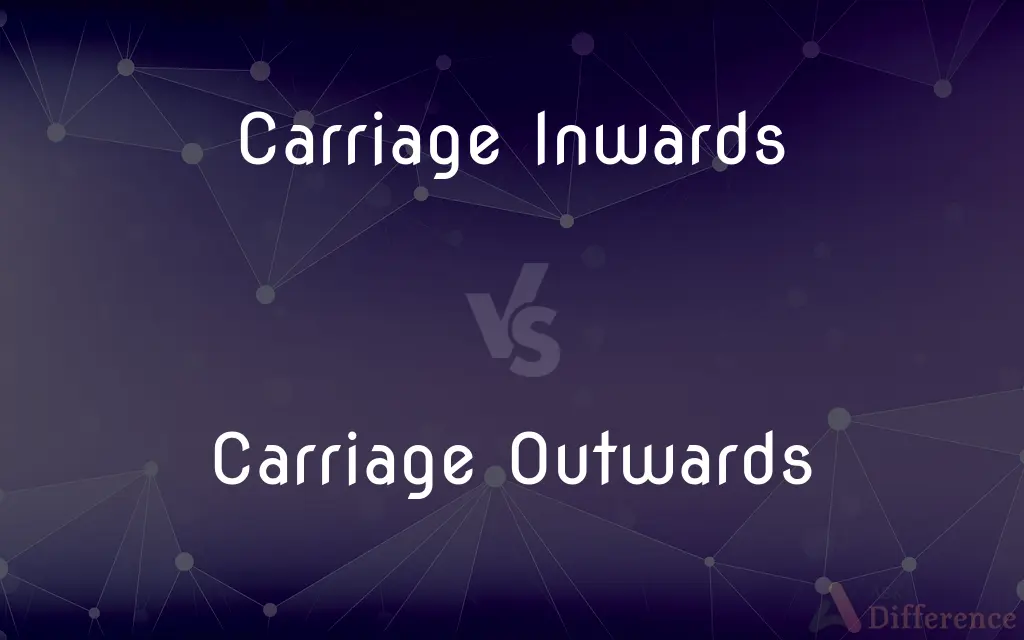Carriage Inwards vs. Carriage Outwards — What's the Difference?
By Tayyaba Rehman — Published on October 15, 2023
Carriage Inwards refers to the costs incurred when a business receives goods; Carriage Outwards pertains to the expenses when a business delivers goods to customers.

Difference Between Carriage Inwards and Carriage Outwards
Table of Contents
ADVERTISEMENT
Key Differences
Carriage Inwards and Carriage Outwards are two different types of transportation costs incurred by businesses in the process of receiving and delivering goods. Carriage Inwards refers to the costs associated with transporting goods from suppliers to the business. This could include freight, delivery, and other logistical costs associated with bringing goods into a business. These costs are typically considered a part of the cost of goods sold as they relate directly to the acquisition of inventory.
Carriage Outwards, conversely, pertains to the costs involved in delivering goods from the business to the customers. These could encompass freight, shipping, and related logistical expenses that are incurred to ensure the goods reach the customers safely and promptly. Unlike Carriage Inwards, Carriage Outwards is accounted for as a selling expense since it directly relates to the sale of goods, and it is not included in the cost of goods sold.
In a financial context, understanding Carriage Inwards and Carriage Outwards is crucial for accurate accounting and financial analysis. While Carriage Inwards affects the valuation of inventory and, subsequently, the gross profit, Carriage Outwards influences the net profit as it is accounted for separately as part of the operating expenses. Thus, differentiating between these two costs is essential for maintaining accurate financial records and assessing the profitability of a business.
Moreover, the treatment of Carriage Inwards and Carriage Outwards in accounting and financial statements is distinct. Carriage Inwards is added to the purchase cost of goods, influencing the value of the inventory, and is considered while calculating the cost of goods sold. In contrast, Carriage Outwards is treated as an expense and is subtracted from the gross profit to ascertain the net profit or loss for a specific period.
In essence, while both Carriage Inwards and Carriage Outwards represent transportation costs, they differ significantly in their implication, treatment, and impact on financial statements. Recognizing this distinction is fundamental for businesses aiming to attain precise financial insights and sustain profitability.
ADVERTISEMENT
Comparison Chart
Relation
Related to goods received by business
Related to goods delivered by business
Financial Treatment
Added to the cost of goods sold
Treated as a selling expense
Impact on Profit
Influences gross profit
Influences net profit
Accounting Category
Considered a part of inventory cost
Considered a part of operating expenses
Effect on Financial Statements
Affects valuation of inventory
Affects calculation of operating income
Compare with Definitions
Carriage Inwards
The costs incurred for transporting goods from suppliers to a business.
The company added the carriage inwards to the purchase cost of the goods.
Carriage Outwards
Affects the net profit and is considered a part of operating expenses.
Due consideration of carriage outwards is essential for accurate profit assessment.
Carriage Inwards
Influences the valuation of inventory and subsequently, the gross profit.
Overlooking carriage inwards can lead to miscalculation of gross profit margins.
Carriage Outwards
Not included in the cost of goods sold but influences net profit calculations.
Proper accounting of carriage outwards ensures reliability of financial statements.
Carriage Inwards
Directly related to the acquisition of inventory and affects the cost of goods sold.
Accurate accounting of carriage inwards is essential for correct valuation of inventory.
Carriage Outwards
The expenses related to delivering goods from a business to its customers.
Carriage outwards reduced the net profit margin of the company.
Carriage Inwards
Considered a part of inventory costs and is added to the purchase cost of goods.
By aggregating carriage inwards with purchase costs, businesses attain precise inventory values.
Carriage Outwards
Treated as a selling expense and subtracted from the gross profit.
Carriage outwards, being a selling expense, influences the calculation of net income.
Carriage Inwards
Integral for maintaining accurate financial records and assessing profitability.
Proper recording of carriage inwards is crucial to avoid financial discrepancies.
Carriage Outwards
Represents the logistical expenses incurred to ensure safe and prompt delivery of goods.
Increasing carriage outwards can significantly impact the financial health of a business.
Common Curiosities
Does Carriage Inwards affect the valuation of inventory?
Yes, Carriage Inwards affects the valuation of inventory and subsequently the gross profit.
Does Carriage Outwards pertain to delivering goods to customers?
Yes, Carriage Outwards pertains to the expenses incurred when a business delivers goods to customers.
Is Carriage Inwards considered a part of the cost of goods sold?
Yes, Carriage Inwards is typically added to the cost of goods sold as it is related to acquiring inventory.
Is Carriage Inwards related to receiving goods?
Yes, Carriage Inwards relates to the costs incurred when a business receives goods from suppliers.
Is Carriage Inwards added to the purchase cost of goods?
Yes, Carriage Inwards is added to the purchase cost of goods, influencing the value of the inventory.
Is Carriage Outwards subtracted from gross profit to calculate net profit?
Yes, Carriage Outwards is subtracted from gross profit to calculate net profit or loss for a specific period.
Can Carriage Inwards influence gross profit calculations?
Yes, Carriage Inwards can influence gross profit calculations by affecting the valuation of inventory.
Is Carriage Outwards treated as a selling expense?
Yes, Carriage Outwards is treated as a selling expense and not included in the cost of goods sold.
Should Carriage Inwards be accurately accounted for to maintain precise financial records?
Yes, accurate accounting of Carriage Inwards is crucial for maintaining precise financial records and assessing profitability.
Does Carriage Outwards influence operating income calculations?
Yes, Carriage Outwards influences operating income calculations as it is considered a part of operating expenses.
Is Carriage Inwards integral to achieving accurate gross profit margins?
Yes, accurate accounting of Carriage Inwards is integral to achieving precise gross profit margins.
Can overlooking Carriage Outwards lead to inaccuracies in financial statements?
Yes, overlooking Carriage Outwards can lead to inaccuracies in calculating net profit in financial statements.
Does Carriage Outwards affect the net profit?
Yes, Carriage Outwards affects the net profit as it is subtracted from the gross profit.
Can Carriage Outwards significantly impact the financial health of a business?
Yes, an increase in Carriage Outwards can significantly impact the net profit and overall financial health of a business.
Is proper recording of Carriage Inwards and Carriage Outwards crucial for financial accuracy?
Yes, proper recording of both Carriage Inwards and Carriage Outwards is crucial for maintaining financial accuracy and reliability of financial statements.
Share Your Discovery

Previous Comparison
Political Parties vs. Interest Group
Next Comparison
Moisturizer vs. Cold CreamAuthor Spotlight
Written by
Tayyaba RehmanTayyaba Rehman is a distinguished writer, currently serving as a primary contributor to askdifference.com. As a researcher in semantics and etymology, Tayyaba's passion for the complexity of languages and their distinctions has found a perfect home on the platform. Tayyaba delves into the intricacies of language, distinguishing between commonly confused words and phrases, thereby providing clarity for readers worldwide.














































